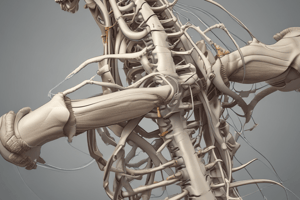Podcast
Questions and Answers
What is the norm for lumbar flexion using the inclinometer?
What is the norm for lumbar flexion using the inclinometer?
- 20 degrees
- 25 degrees
- 30 degrees
- 60 degrees (correct)
What measurement is taken for lumbar extension using the inclinometer?
What measurement is taken for lumbar extension using the inclinometer?
- 60 degrees
- 15 cm
- 20-25 degrees (correct)
- 10 cm
Where do you place the inclinometer for lumbar flexion?
Where do you place the inclinometer for lumbar flexion?
S2 to T12
Norm for thoracolumbar lateral flexion is _____ degrees.
Norm for thoracolumbar lateral flexion is _____ degrees.
The norm for thoracolumbar rotation is 33 degrees in each direction.
The norm for thoracolumbar rotation is 33 degrees in each direction.
What is the normal measurement when using a tape measure for thoracolumbar lateral flexion, method 1?
What is the normal measurement when using a tape measure for thoracolumbar lateral flexion, method 1?
What is the norm for thoracolumbar lateral flexion using the inclinometer?
What is the norm for thoracolumbar lateral flexion using the inclinometer?
What is the expected difference in centimeters for lumbar flexion using the Schober method?
What is the expected difference in centimeters for lumbar flexion using the Schober method?
The thoracolumbar extension norm is _____ cm difference.
The thoracolumbar extension norm is _____ cm difference.
Flashcards are hidden until you start studying
Study Notes
Lumbar Spine ROM Measurement Techniques
- Inclinometer Method for Lumbar Flexion/Extension/Lateral Flexion
- Place the inclinometer on S2 (between PSIS) and T12 (last rib).
- Measure at zero while the patient performs toe touch.
- Subtract the difference to calculate the range of motion.
- Normal ranges:
- Flexion: 60 degrees
- Extension: 20-25 degrees
- Lateral flexion: 25-30 degrees
Schober Method for Lumbar Flexion/Extension
- Tape Measure Technique
- Measure distance from S2 to T12, marking 15 cm up from S2.
- Normal flexion: 6-7 cm (measured difference between start and end range).
- Normal extension: 1.5 cm difference.
Thoraco-Lumbar Flexion/Extension
-
Inclinometer Method
- Place inclinometer on T1 and S2.
- Normal flexion: 60 degrees.
-
Tape Measure Technique
- Measure from C7 to S2.
- Normal measure is 10 cm (difference from start to end range).
- Ensure stabilization of pelvis to prevent anterior pelvic tilt.
Thoracolumbar Lateral Flexion Measurements
-
Inclinometer Method
- Place inclinometer from T1 to S2.
- Normal lumbar lateral flexion ranges between 25-30 degrees.
-
Goniometer Technique
- Standing position: stationary arm perpendicular to the floor, axis at S2, moving arm along C7.
- Normal range: 35 degrees.
Thoracolumbar Lateral Flexion with Tape Measure
-
Method 1: Finger Tip to Thigh
- Measure from fingertip of 3rd finger to thigh.
- Normal range is 22 cm (difference between relaxed stance and laterally flexed position).
-
Method 2: Finger Tip to Floor
- Normal range is 16-17 cm.
- This measure may be affected by patient's body size; best used for repeated measures on the same subject.
Thoracolumbar Rotation Measurements
-
Inclinometer Method
- Using T1 to S2; patient bends to touch the opposite arm; normal rotation is 33 degrees in each direction.
-
Goniometer Technique
- Seated position; turn trunk to the left during measurement.
- Set stationary arm with acromion, moving arm parallel to acromions, and axis at the top of the subject's head.
- Normal range: 45 degrees, emphasizing the importance of maintaining proper posture.
Studying That Suits You
Use AI to generate personalized quizzes and flashcards to suit your learning preferences.




